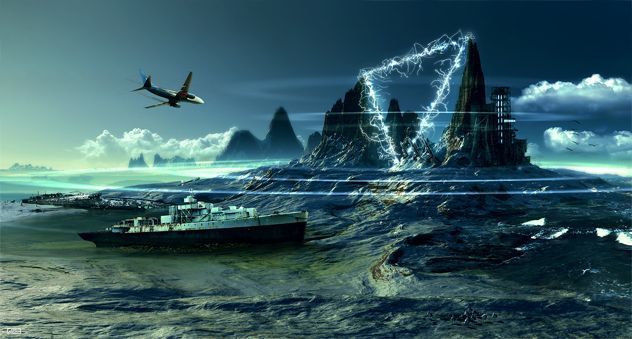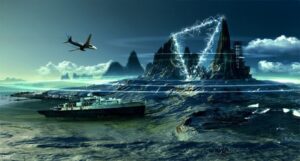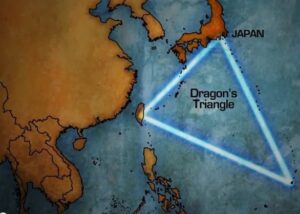
Kavindya Senevirathna


The sea is a vital resource for human life, and it is known for its calm, sometimes scary, and mysterious events. Several specific places around the world have become famous for their dark stories and disappearances. Among them, another area that has been talked about similarly to the Bermuda Triangle is the “Dragon’s Triangle.” It is located off the coast of Japan and has been the subject of various explanations, ranging from ancient sailors’ legends to modern scientific explorations.
Throughout history, there have been records of ships and aircraft disappearing here, and some believe that this is an area of dark forces. On the other hand, scientists point out that these are normal processes such as deep-sea currents, tectonic collisions, and magnetic field fluctuations. But since definitive answers cannot be found, the Dragon’s Triangle continues to gain popularity around the world as a unique place full of mysteries and fascination.
Geographical Location and History of the Dragon’s Triangle
The Dragon’s Triangle (also known as the Devil’s Sea) is a sea area off the coast of Japan, known for its dark legends and mysterious events. It is an “undiscovered” sea triangle, similar to the Bermuda Triangle. It is generally considered to be located in the ecological zone southwest of Tokyo, between the Japanese islands, Guam, and the Mariana Islands. Some believe that this area is characterized by strong magnetic fluctuations in the ocean and deep ocean currents, further causing problems.
There are various accounts of this area throughout history. Ancient Japanese sailors called it “Makumono Umi” (Sea of the Gods), and there were many stories of their ships disappearing suddenly. Historians say that many ships of the Mongol invasion forces disappeared here in the 13th century. Because of this, the Dragon’s Triangle became the subject of ancient stories and legends.
In the 1950s, this area came to the attention of the Western world, especially through the Japanese media and exploration. It became known as the “Undiscovered Sea Triangle.” With the disappearance of ships, aircraft, and sailors, this area became a problem zone similar to the Bermuda Triangle.
Throughout history, two theories have been developed about the Dragon’s Triangle. One is the idea that this is a normal phenomenon caused by geographical and environmental problems. The other is the legend that it belongs to dark, demonic, or mysterious forces. For this reason, the Dragon’s Triangle remains a popular topic of discussion today and continues to be another unfinished mystery that blends scientific and mystical history.
Disappearances and Unsolved Mysteries
The Dragon’s Triangle is considered a hotbed of disappearances, dark events, and alternative legends. At various times in history, ships, planes, and people have disappeared here. All of these confirm that it has a similar reputation to the Bermuda Triangle.
According to old records, many Japanese fishing boats and merchant ships disappeared here. In 1952, a Japanese exploration ship also disappeared in the Dragon’s Triangle. It has been written that the defense ships sent to find the missing vessel also vanished. It is also said that the Japanese government restricted the area to ships and exploration projects for several years because of these incidents.
Another very common story is that of the Mongol invasion fleet. In the 13th century, a fleet that came to invade Japan disappeared here due to strong storms and sea disasters. History records that this led to the loss of many people and ships in the Dragon’s Triangle, making it a place of fear in Japanese folklore.
Some scientists say that the disappearances are due to normal environmental factors such as deep-sea problems, magnetic fluctuations, earthquakes, and storms. However, folklore has attributed them to “dark forces” or “demonic magic.”
Although attempts have been made to uncover the truth about these events, there is still no definitive evidence to explain all the circumstances. As a result, the disappearances in the Dragon’s Triangle remain a mysterious and frightening story.
Difference Between Scientific Analysis and Folklore
There are two different versions of the story about the Dragon’s Triangle – scientific analysis and folklore.
According to scientific analysis, this area is considered a place of high risk due to deep ocean problems and geological processes. Located between the Japanese islands and the Mariana Trench, this area is prone to plate collisions and earthquakes. Scientists say that such collisions sometimes cause ships and aircraft to disappear. Also, since deep-sea currents and strong storms are constant here, shipwrecks and disappearances of people are not uncommon.
Another scientific argument involves magnetic field variations. Some scientists say that due to magnetic effects in this area, it is common for navigational instruments and aircraft to malfunction, lose their way, and cause accidents.
But folklore goes in another direction. In Japanese folklore, the Dragon’s Triangle was called the “Sea of the Gods,” and it was described as a “kingdom of dark forces.” Some believed that it was inhabited by aliens, while others believed that it belonged to a demonic realm.
There is also a middle ground between the two. Some believe that scientific facts and folklore have come together to create this situation. For example, disappearances caused by storms and deep-sea currents have been attributed to dark supernatural forces in folklore.
In any case, the Dragon’s Triangle remains one of the world’s most popular “unsolved mysteries” due to the tension between scientific analysis and folklore.
The Dragon’s Triangle is neither a mystery based entirely on science nor on folklore, but rather a unique combination of both. Although it is located off the coast of Japan, it is a mysterious triangle that has captured the attention of people all over the world. Modern explorations indicate that it is affected by normal environmental influences such as storms, deep-sea currents, earthquakes, and magnetic field fluctuations. But despite all these factors, it is always difficult to definitively explain disappearances and strange events, so folklore persists.
The Dragon’s Triangle is an example of how our world cannot be fully explained by simple scientific conditions. It belongs to both scientific explanations and myths, and it fuels human curiosity even further. Whether a definitive answer is ever found, or whether it remains a mystery, the Dragon’s Triangle will forever hold a unique position among the world’s most famous undiscovered secret locations.